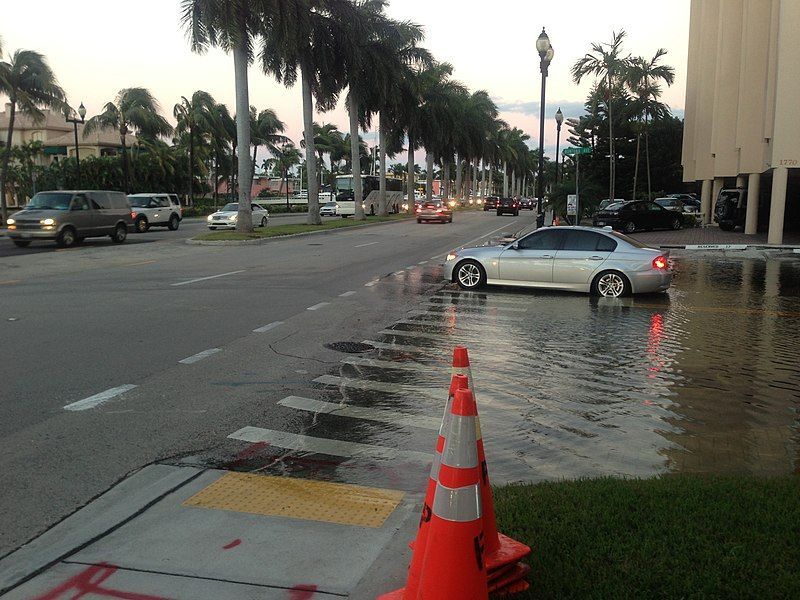Call Us Today - 1 (860) 222-3055
Page 5
Media Contact
Email: media@floodpanel.com
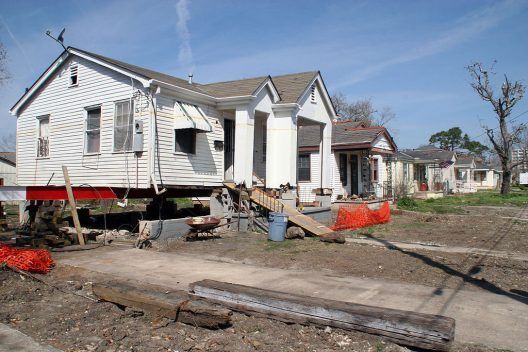
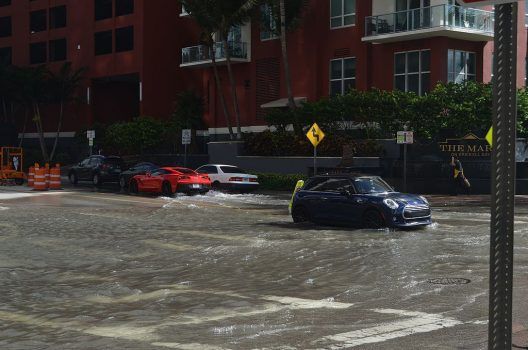
PHOTO: Sunny day high tide nuisance flooding in Brickell, downtown Miami Florida. The morning high tide on October 17, 2016. Roughly 4.0 ft MLLW, +3 ft above MSL, 2 ft NAVD 88, about 1.75 feet MHHW for Miami, Virginia Key tide gauge. This location rounds to 0 meters/0 feet AMSL.
“Sunny Day Flooding”, also known as tidal flooding, is a phenomenon that occurs when low-lying areas are temporarily flooded during periods of unusually high tides, such as during a full moon. This may happen when the sky is clear and sunny, with not a single cloud on the horizon. During a sunny day flood event, streets can be covered by water in an unexpected way, because residents are not prepared for floods in the absence of rain or storms. Nevertheless, this flooding does occur during dry weather, and the frequency of these floods is increasing in an alarming way.
This summer, the federal government issued a warning to those who live in and around low-lying zones. The National Oceanic and Atmospheric Administration (NOAA) has identified dozens of communities that will suffer an increase in sunny day floods, from Miami to San Diego. The increase that is expected during the coming year is attributed to an abnormally active El Niño weather pattern, combined with sea level rise that is happening across the globe. Rapidly melting ice caps and glaciers from Antarctica to Greenland continue to feature prominently in news coverage, and videos of huge chunks of polar ice calving into the sea remind us all that we can expect major changes, and soon!
One of those changes is sure to be a flood-filled future. This year, with the hyperactive El Niño weather pattern in play, all types of floods are predicted to be a problem. But the “sunny day flood” brings a special kind of threat, mostly due to the general lack of preparation of those affected. Sea level rise, coupled with sinking coastlines along the eastern seaboard, has greatly increased the number of affected communities. During these “sunny day floods”, roads are often covered by water; and in many cases vital thoroughfares are closed until the water recedes. Flooded roads are subsequently plagued by potholes, erosion of shoulders, and instability of the roadbed, which can lead to washouts.
In addition to road damage, affected communities also suffer many other negative consequences from frequent flooding. Basements and underground parking structures for homes and businesses fill with water again and again, followed by days or weeks of backbreaking clean-up. Storm water systems can become overwhelmed and damaged, and septic systems can overflow, polluting property and waterways. Many homes in rural areas rely on septic systems for disposing of toilet wastewater, so one can only imagine how inconvenient it must be when these systems become temporarily unusable due to flooding.
Low-lying areas are particularly vulnerable, of course, and nowhere in the US is more threatened than Florida. With much of the state at or below 10′ above sea level, every inch lost to sea level rise or subsidence (sinking) of the coastline translates to real hardship for the people living in these areas. After the floods have receded, many homeowners find the rebuilding process to be all but impossible. Flood insurance, for those lucky enough to have it, becomes prohibitively expensive after a series of floods. Insurance companies or community code may suddenly require that a building be raised on stilts, or that repairs shall not be possible at all. Some zones may be declared no longer supported for rehabilitation, and repair of buildings in these areas would become illegal. When that happens, the buildings must by law be left to slowly fall apart by attrition and neglect, even as the property owner may still have to pay a mortgage for the uninhabitable home.
This year may be particularly hard for home and business owners in these low-lying communities. While coastal zones have typically suffered about five days a year of “sunny day flooding”, this record will most likely be smashed during the 2019-20 flood season. But even this is nothing compared to the predictions for 2050, by which time “sunny day floods” are projected to become a very common nuisance. Within the next thirty years, it is thought that many unlucky communities will suffer sunny day floods up to 100 days out of each year!
Source:: FloodBarrierUSA
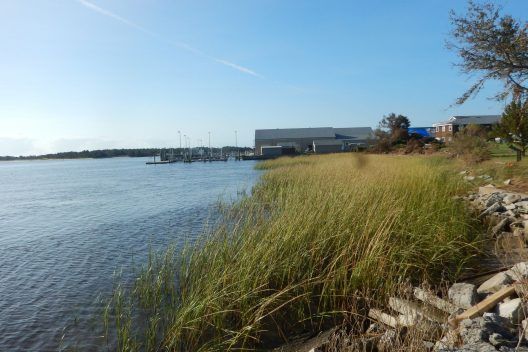
PHOTO: The living shoreline of cordgrass and oyster reef was built by NOAA to protect Pivers Island in Beaumont, North Carolina. NOAA Fisheries
Oysters and other shellfish are highly popular menu items, particularly in coastal towns where fresh seafood is readily available. These seaside communities are also the very places most likely to suffer flooding — and now an ingenious plan has been concocted to utilize the mountains of used shells generated by the eateries. There is now a plan to use the shells to reduce flooding!
Scientists have long known that oyster beds can help anchor vulnerable coastline and prevent erosion. However valuable these beds may be as far as environmental protection, they have not been adequately protected from overfishing and other depredations. In addition to the threat from over-harvesting, large swaths of oyster populations have been severely damaged by the increasingly intense storms that have decimated the coastline in recent decades; even established oyster reefs can be damaged if the storm is fierce enough. Acidification of the oceans due to man-made pollution also takes a toll. And lastly, oyster populations have been scraped off the sea floor by dredging and pier construction projects.
Now, thanks to recently developed techniques, there are plans in place around the country to rebuild the huge oyster communities of yesteryear, using discarded oyster shells to help get the new shellfish started. The new plans use the natural habits of the oysters to benefit both shellfish and humans! Oysters typically cement themselves to a fixed, hard object as part of their survival strategy. Lacking means of locomotion, they must affix themselves to a permanent location that offers good water circulation. Oysters are filter feeders and are believed to filter up to 50 gallons of water per day. Plankton, decomposing plant and animal material, and other organic particles are filtered by the oysters and utilized to glean nutrients. Oysters are extremely efficient as filters of other undesirable compounds and matter as well, such as nitrogen and algae, and are able to greatly improve the health and clarity of the water bodies that host them. This is yet another beneficial side product of the flood-busting scheme.
As the oysters cement themselves to the sea floor or other underwater features, their irregular shells provide habitat for many other aquatic creatures. Over time, with good husbandry and ideal conditions, huge reefs of oysters can build up, and these reefs can act as natural sea walls. The obvious advantage of these living flood barriers is that they are built and maintained by the natural organisms themselves! Once the oyster reefs are “planted” in the desirable location, the oyster reef is built over time by the oysters, and is always getting bigger and stronger with no further expenditure of dollars or human labor.
So attractive is this relatively cheap and extremely effective natural flood barrier, that federal grants have recently become available to initiate “artificial” oyster reefs in strategic locations from Manhattan to Louisiana. Enter the contributions from the seafood industry: here is where those mountains of used shells are put to good use. Oyster fry must find shelter in order to survive, and the corrugated shape of natural oyster shells are the best bet for them to find protection while they mature. So now, instead of discarding huge mounds of shells into landfills, an after-market has been created to make use of the shells in the most environmentally positive way. The used oyster shells are placed in the correct locations to form natural sea walls, and fry are introduced. Soon the dead shells provide the right conditions for new living reefs to form, and the mature oysters begin to clean the water even as they help protect from floods. A true win-win scenario!
Source:: FloodBarrierUSA
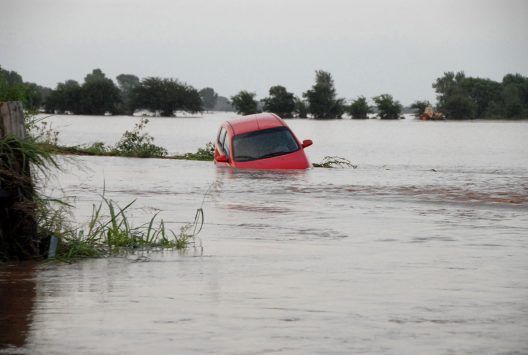
Floods are defined as the sudden covering of normally dry land with water, usually from melting snow, burst dams, storm surge, or heavy rains. Floods can occur in any of the 50 states of the United States, and are the most common reason for a Declaration of Emergency announced by the President. Hurricanes almost always result in flooding disasters, and climate scientists believe that these massive storms will become more frequent and more destructive over the coming decades. As flooding becomes more frequent and more widespread, there will be floods in places that have rarely suffered this fate in the past. Today we take a look at some facts about floods, including a few that may be quite surprising.
Flood damage is rarely included in home or property insurance policies. Unfortunately, this very often comes as a surprise to the homeowner. To be covered for flooding, a special flood insurance policy must be purchased. In some areas, this policy can be prohibitively expensive or even not available at all!
It does not take much water to carry off a vehicle. Even a bus can be swept away by as little as two feet of water! Every year drivers who are attempting to flee floods make the deadly decision to drive through shallow but fast-moving floodwater, only to be caught up in the flood with no control over the vehicle.
Floods can happen in places where not a drop of rain is falling. The most common scenario is a placid river that suddenly becomes a death trap when a flash flood appears from unseen heavy rain upstream. These flash floods can present a wall of water up to 20′ high, with absolutely no warning!
Natural flooding is essential for farming. We all learned in grade school about the Fertile Triangle and the cradle of civilization, and that this annual flooding from the Tigris and Euphrates was necessary for the deposit of rich new soil for agriculture. Today farmers around the world still depend on floods for the same reason, and have adopted seasonal migrations to avoid the damage while reaping the benefits of this regular flooding.
The world’s most deadly flooding took place in the year 1931, along the Yellow River in China. Between 1-4 million people lost their lives during a series of floods that year.
The most common source of flooding is a river that overflows its banks during heavy snowmelt or rainfall. People who live or own businesses near rivers or estuaries must be prepared for flood damage year after year.
Wetlands are extremely important as flood mitigation agents. Wetlands act as a natural sponge to absorb extra water safely. Communities that preserve natural wetlands or even create new ones are likely to fare better during heavy rainfall or storm surges. Conversely, communities that destroy or develop wetlands are likely to experience destructive ‘areal flooding’ which occurs when there is no place for the water to go. Areal flooding occurs when wetlands are not available, and the land surface is saturated or non-permeable, such as concrete.
A full 17% of urban land resides within the 100-year flood plain. This is very bad news for these areas, as we have seen these so-called 100-year floods happening with increasing frequency- much more often than every 100 years!
Floods can happen even in a desert. As our climate changes and weather patterns shift, heavy rainfall can occur in places that were formerly reliably dry. Deserts, with arid soil and little vegetation, cannot absorb water quickly, leading to flooding.
Flood prevention measures return almost $5 for every $1 invested. With floods becoming more common every year, those who own homes or other properties must now race to invest in flood panels and other mitigation methods before heavy losses are incurred.
Source:: FloodBarrierUSA
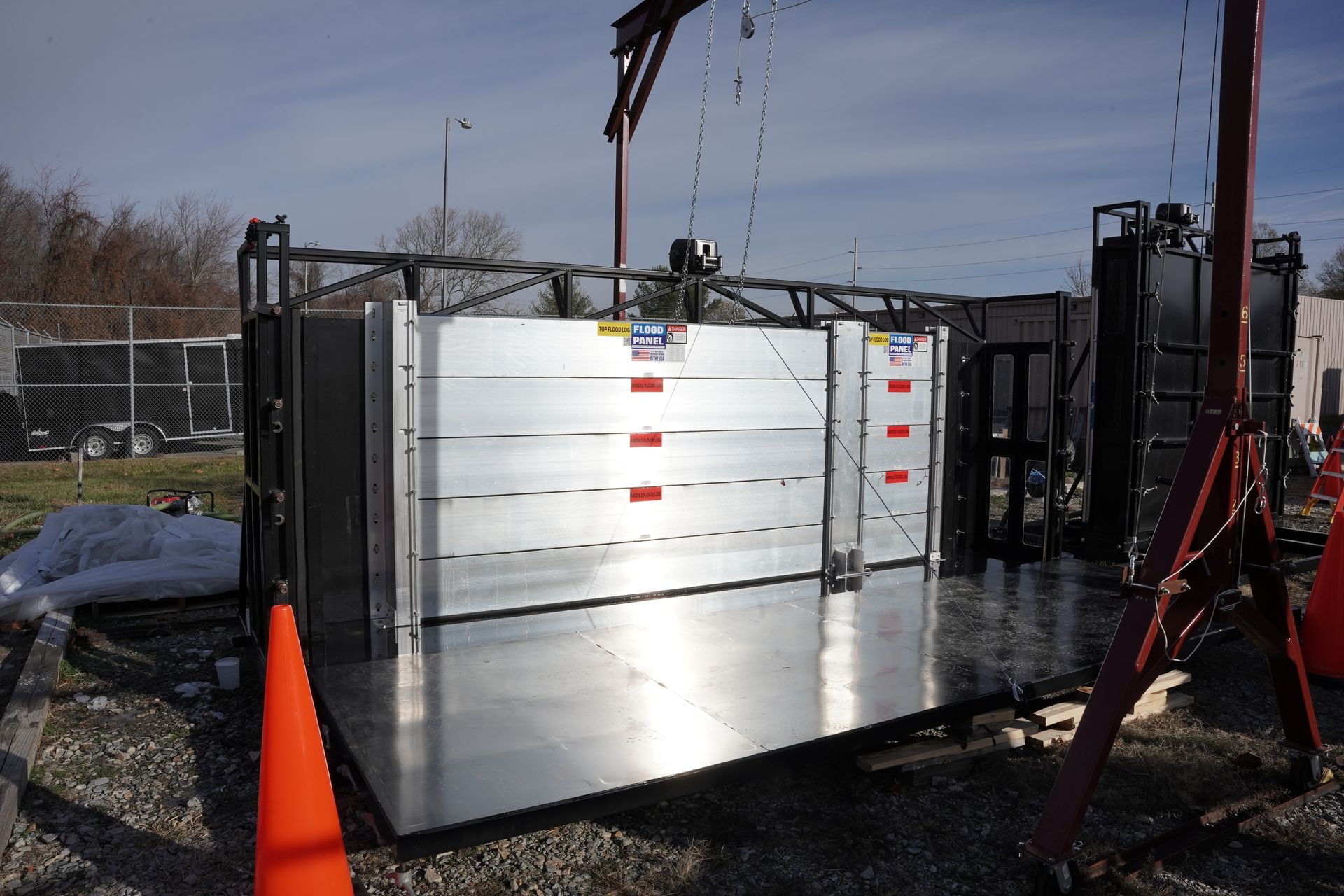
Tell us about your project
We look forward to the opportunity to earn your business and to become a value-added partner on your design and construction team.
Contact Us
Contact Us
Phone:
1-860-222-3055
Address: 1555 Jupiter Park Drive, Suite 5, Jupiter, FL 33458

